Changes in the Dynamics of the Northern Hemisphere Atmospheric Circulation and the Relationship to Surface Temperature in the 20th and 21st Centuries
Abstract
1. Introduction
2. Data and Methods
2.1. Data
2.2. Methods
2.3. Shannon or Information Entropy
3. Results
3.1. Circulation Epochs
3.2. Global Surface Temperatures
3.3. Circulation Epochs and Information Entropy
4. Summary and Conclusions
- the end of the third circulation epoch (starting in 1957) since 1899 may be occurring as the frequency of Type 3 + Type 4 (meridional) NH flows has occurred more frequently. The period 1981–2018 is characterized by a strong increase in Type 4 NH flows. The occurrence of Type 3 flows overtook the occurrence of Type 4 flows again in the early 2000s, but it is not yet clear that a new epoch or sub-period has begun as Type 4 flows became more common again. This may be partly due to the recent strong 2014–2016 El Niño;
- the NH teleconnection indexes (e.g., AO, NAO) of the late 20th and early 21st centuries have varied along with the frequency of Type 3 and Type 4 flows consistent with [1] and references therein;
- the correspondence of NH and SH atmospheric flows as proposed by D67 and in [10,11] showed promise as identified by two additional tests. There is a significant correlation between the AO and AAO Indexes for the period 1998–2018 (when these indexes were available and most robust). The occurrence of atmospheric blocking time series in each hemisphere from 1970 to 2018 correlated very strongly hemisphere wide as well as by sector;
- the global surface temperature trends including those of the early 21st century significantly correlated to the circulation epochs and sub-periods identified in the text;
- the quantity, Shannon or Information Entropy, corresponded to the occurrence of zonal versus meridional NH flows (as well as NH surface temperatures) during the period from 1899 to 2018 and was not random as an unbiased coin toss or as suggested by theory (in [14]—or the DKV46 classification scheme). The first two epochs were similar to the entire period overall, but the third epoch (1957–2018) was significantly different and biased toward the more frequent occurrence of meridional flows. Thus, the Shannon or Information Entropy has utility as a diagnostic tool in atmospheric science. It may have use in an operational or seasonal range forecasting environment as well as in examining future climate scenarios produced by models.
Author Contributions
Funding
Acknowledgments
Conflicts of Interest
References
- Lebedeva, M.G.; Lupo, A.R.; Chendev, Y.G.; Krymskaya, O.V.; Solovyev, A.B. Changes in the atmospheric circulation conditions and regional climatic characteristics in two remote regions since the mid-20th century. Atmosphere 2019, 10, 11. [Google Scholar] [CrossRef]
- Lupo, A.R.; Jensen, A.D.; Mokhov, I.I.; Timazhev, A.V.; Eichler, T.; Efe, B. Changes in Global Blocking Character in Recent Decades. Atmosphere 2019, 10, 92. [Google Scholar] [CrossRef]
- Allen, R.A.; Fletcher, R.; Holmboe, J.; Namias, J.; Willett, H.C. Report on an Experiment in Five-Day Weather Forecasting; Massachusetts Institute of Technology and Woods Hole Oceanographic Institution: Woods Hole, MS, USA, 1940. [Google Scholar]
- Van Loon, H.; Rogers, J.C. The Seesaw in Winter Temperatures between Greenland and Northern Europe. Part I: General Description. Mon. Wea. Rev. 1978, 106, 296–310. [Google Scholar] [CrossRef]
- Dzerdzeevskii, B.L.; Kurganskaya, V.M.; Vitviskaya, Z.M. The Classification of Circulation Mechanisms in the Northern Hemisphere and the Characteristics of Synoptic Seasons. In Synoptic Meteorology; Gidrometizdat: Leningrad, Russia, 1946. [Google Scholar]
- Kononova, N.K. The Classification of Northern Hemisphere Circulation Mechanisms According to B.L. Dzerdzeevskii; Izdatel’stvo “Voyentekhinizdat”: Moscow, Russia, 2009. [Google Scholar]
- Dzerdzeevskii, B.L. A comparison of the main regularities of atmospheric circulation over the Northern and Southern Hemispheres. Inf. Bull. Sov. Antarct. Exped. 1967, 65, 58–68. [Google Scholar]
- Kononova, N.K. Circulation of the atmosphere in the European Sector of the Northern Hemisphere in the 21st Century and fluctuations in air temperature in the Crimea. Geopolit. Ecogeodynamics Reg. 2014, 10, 633–639. [Google Scholar]
- Kononova, N.K. Peculiarities of the atmospheric Circulation of the Northern Hemisphere during the end of the 20th—Beginning of the 21st Centuries and its reflection in the climate. Complex Syst. 2014, 2, 11–35. [Google Scholar]
- Kononova, N.K. Changes of the Atmospheric Circulation in the Northern Hemisphere in the 20th–21st Centuries and their consequences for the climate. Fundam. Appl. Climatol. 2015, 1, 127–156. [Google Scholar]
- Kononova, N.K. Circulating epochs in the sectors of the Northern Hemisphere from 1899–2014. Geopolit. Ecogeodynamics Reg. 2015, 11, 56–66. [Google Scholar]
- Kononova, N.K. Fluctuations in the global atmospheric circulation in the 20th–21st Centuries. Complex Syst. 2016, 4, 22–37. [Google Scholar]
- Kononova, N.K. Types of the global atmospheric circulation: Monitoring and retrospective assessment results for 1899–2017. Fundam. Appl. Climatol. 2018, 3, 108–123. [Google Scholar] [CrossRef]
- Lorenz, E.N. Deterministic, non-periodic flow. J. Atmos. Sci. 1963, 20, 130–141. [Google Scholar] [CrossRef]
- Hansen, A.R. Observational characteristics of atmospheric planetary waves with bimodal amplitude distributions. Adv. Geophys. 1986, 29, 101–134. [Google Scholar]
- Sutera, A. Probability density distribution of large-scale atmospheric flow. Adv. Geophys. 1986, 29, 227–250. [Google Scholar]
- Charney, J.G.; DeVore, J.G. Multiple flow equilibria in the atmosphere and blocking. J. Atmos. Sci. 1979, 36, 1205–1216. [Google Scholar] [CrossRef]
- Mo, K.; Ghil, M. Cluster analysis of multiple planetary flow regimes. J. Geophys. Res. 1988, 93, 10927–10952. [Google Scholar] [CrossRef]
- Franzke, C.; Woollings, T.; Martius, O. Persistent circulation regimes and preferred regime transitions in the North Atlantic. J. Atmos. Sci. 2011, 68, 2809–2825. [Google Scholar] [CrossRef]
- Michel, C.; Rivière, G. The link between Rossby wave breakings and weather regime transitions. J. Atmos. Sci. 2011, 68, 1730–1748. [Google Scholar] [CrossRef]
- Huang, W.; Chen, R.; Wang, B.; Wright, J.S.; Yang, Z.; Ma, W. Potential vorticity regimes over East Asia during winter. J. Geophys. Res. Atmos. 2016, 122, 1524–1544. [Google Scholar] [CrossRef]
- Jensen, A.D.; Lupo, A.R.; Mokhov, I.I.; Akperov, M.G.; Reynolds, D.D. Integrated regional enstrophy and block intensity as a measure of Kolmogorov Entropy. Atmosphere 2017, 8, 237. [Google Scholar] [CrossRef]
- Dymnikov, V.P.; Kazantsev, Y.V.; Kharin, V.V. Information entropy and local Lyapunov exponents of barotropic atmospheric circulation. Izv.-Russ. Acad. Sci. Atmos. Ocean. Phys. 1992, 28, 425–432. [Google Scholar]
- Shannon, C.E. A mathematical theory of communication. Bell Syst. Tech. J. 1948, 27, 379–423. [Google Scholar] [CrossRef]
- Jaynes, E.T. Information theory and statistical mechanics. Phys. Rev. 1957, 106, 620–630. [Google Scholar] [CrossRef]
- Liu, Y.; Liu, C.; Wang, D. Understanding atmospheric behavior in terms of entropy: A review of Applications of the Second Law of Thermodynamics to meteorology. Entropy 2011, 13, 211–240. [Google Scholar] [CrossRef]
- Institute of Computational Mathematics (Russian Academy of Sciences). Available online: https://www.inm.ras.ru/en/ (accessed on 4 February 2020).
- Climatic Research Unit (CRU), University of East Anglia. Temperature data (HadCRUT4, CRUTEM4) Climatic Research Unit Global Temperature, Climatic Research Unit. 2019. Available online: https://crudata.uea.ac.uk/cru/data/temperature/ (accessed on 12 March 2019).
- The University of Missouri Blocking Archive. Available online: http://weather.missouri.edu/gcc (accessed on 6 August 2019).
- National Oceanic and Atmospheric Administration (NOAA) Climate Prediction Center (CPC) Teleconnections. Available online: https://www.cpc.ncep.noaa.gov/products/precip/CWlink/daily_ao_index/month_ao_index.shtml (accessed on 29 July 2019).
- Dzerdzeevskii, B.L. Fluctuations of Climate and of General Circulation of the Atmosphere in Extra-tropical Latitudes of the Northern Hemisphere and Some Problems of Dynamic Climatology. Tellus 1962, 14, 328–336. [Google Scholar] [CrossRef]
- Dzerdzeevskii, B.L. Circulation Mechanisms in the Atmosphere of the Northern Hemisphere in the Twentieth Century. In Materials of Meteorological Research; Institute of Geography of the USSR Academy of Sciences and the Interagency Geophysical, Committee under the Presidium of the USSR Academy of Sciences: Moscow, Russia, 1968; p. 240. [Google Scholar]
- Dzerdzeevskii, B.L. Selected Works, General Circulation of the Atmosphere and Climate. Science 1975. [Google Scholar]
- Lebedeva, M.G.; Krymskaya, O.V.; Lupo, A.R.; Chendev, Y.G.; Petin, A.N.; Solovyev, A.B. Trends in summer season climate for Eastern Europe and Southern Russia in the early 21st Century. Adv. Meteorol. 2016. [Google Scholar] [CrossRef]
- The National Centers for Environmental Prediction—National Centers for Atmospheric Research. Available online: https://www.esrl.noaa.gov/psd/data/gridded/data.ncep.reanalysis.html (accessed on 20 February 2020).
- Kononova, N.K. Fluctuations in the Atmospheric Circulation of the Northern Hemisphere in the 20th and Early 21st Century. Available online: https://atmospheric-circulation.ru/ (accessed on 12 March 2019).
- Dzerdzeevskii, B.L. Circulation Schemes of the Seasons in the Northern Hemisphere. Izvestiya of the SSSR Academy of Sciences. Geography 1957, 1, 36–55. [Google Scholar]
- Dzerdzeevskii, B.L. The Problem of Fluctuations in the General Circulation of the Atmosphere and the Climate. In Modern Problems of Climatology; Voeikov, A.I., Ed.; Gidrometizdat: Leningrad, Russia, 1956; pp. 109–122. [Google Scholar]
- Chaplygina, A.S. Fluctuations in the circulation of the atmosphere and the climatic regime of the Earth. Physical and Dynamic Climatology. Gidrometizdat 1974, 30, 209–217. [Google Scholar]
- Kononova, N.K. Fluctuations in the circulation of the atmosphere and air temperature in the Northeast of Siberia in the 20th and Early 21st Centuries. In Proceedings of the International Conference, Sustainable Nature Management in Coastal Marine Zones; Izdatel’stvo “Dal’nauka”: Vladivostok, Russia, 2013; pp. 62–66. [Google Scholar]
- Risbey, J.S.; O’Kane, T.J.; Monselesan, D.P. Metastability of Northern Hemisphere Teleconnection Modes. J. Atmos. Sci. 2015, 72, 35–54. [Google Scholar] [CrossRef]
- Halpert, M.; Bell, G. Climate assessment for 1996. Bull. Am. Meteor. Soc. 1997, 78, S1–S49. [Google Scholar] [CrossRef]
- Visbeck, M.; Hurrell, J.; Polvani, L.; Cullen, H. The North Atlantic Oscillation: Past, present, and future. Proc. Natl. Acad. Sci. USA 2001, 98, 12876–12877. [Google Scholar] [CrossRef] [PubMed]
- Minobe, S. A 50–70-Year Climatic Oscillation over the North Pacific and North America. Geophys. Res. Lett. 1997, 24, 683–686. [Google Scholar] [CrossRef]
- Wang, Y.-H.; Magnusdottir, G.; Stern, H.; Tian, X.; Yu, Y. Decadal variability of the NAO: Introducing an augmented NAO index. Geophys. Res. Lett. 2012, 39, L21702. [Google Scholar] [CrossRef]
- Woollings, T.; Barriopedro Cepero, D.; Methven, J.; Son, S.-W.; Harvey, B.; Martius, O.; Sillmann, J.; Lupo, A.R.; Seneviratne, S. Blocking and it’s response to climate change. Curr. Clim. Chang. Rep. 2018, 4, 287–300. [Google Scholar] [CrossRef] [PubMed]
- Intergovernmental Panel on Climate Change (IPCC). Climate Change 2013: The Physical Scientific Basis. 2013. Available online: http://www.ipcc.ch (accessed on 27 June 2019).
- Savina, S.S.; Khmelevskaya, L.V. Dynamics of Atmospheric Processes in the Northern Hemisphere in the Twentieth Century; Soviet Geophysical Committee at the Presidium of the USSR Academy of Sciences: Moscow, Russia, 1984. [Google Scholar]
- Wyatt, M.G.; Curry, J.A. Role for Eurasian Arctic shelf sea ice in a secularly varying hemispheric climate signal during the 20th century. Clim. Dyn. 2013. [Google Scholar] [CrossRef]
- Byshev, V.I.; Serykh, I.V.; Sidorova, A.N.; Sklyarov, V.E.; Anisimov, M.V. Oceanic factor of multi-decadal variability of the current climate. Oceanol. Stud. 2018, 46, 5–19. (In Russian) [Google Scholar]
- Serykh, I.V. On the dynamics and structure of global atmospheric oscillation in climate models and in reality. Oceanol. Stud. 2018, 46, 14–28. (In Russian) [Google Scholar] [CrossRef][Green Version]
- Scafetta, N. Solar Oscillations and the Orbital Invariant Inequalities of the Solar System. Sol. Phys. 2020, 295, 33. [Google Scholar] [CrossRef]
- Kukoleva, A.A.; Kononova, N.K.; Krivolutsky, A.A. Manifestation of the solar cycle in the circulation characteristics of the lower atmosphere in the Northern Hemisphere. Geomagn. Aeron. 2018, 58, 808–817. [Google Scholar] [CrossRef]
- Fedorov, V.M.; Frolov, D.M. Spatial and temporal variability of solar radiation coming to the upper boundary of the atmosphere. Space Res. 2019, 57, 177–184. (In Russian) [Google Scholar]
- Neter, J.; Wasserman, W.; Whitmore, G.A. Applied Statistics, 3rd ed.; Allyn and Bacon Press: Boston, MA, USA, 1988; p. 2029. [Google Scholar]
- Jantschi, L.; Bolboaca, S.D. Performances of Shannon’s Entropy statistic in assessment of distribution of data. Ovidius Univ. Ann. Chem. 2017, 28, 30–42. [Google Scholar] [CrossRef]
- Wiedenmann, J.M.; Lupo, A.R.; Mokhov, I.I.; Tikhonova, E.A. The climatology of blocking anticyclones for the Northern and Southern Hemisphere: Block intensity as a diagnostic. J. Clim. 2002, 15, 3459–3474. [Google Scholar] [CrossRef]
- Wilks, D.S. Statistical Methods in the Atmospheric Sciences, 2nd ed.; Int. Geophys Series number 91; Academic Press: Cambridge, MA, USA, 2006; p. 627. [Google Scholar]
- Francis, J.A.; Vavrus, S.J. Evidence linking Arctic amplification to extreme weather in the mid-latidudes. Geophys. Res. Lett. 2011, 39, L06801. [Google Scholar] [CrossRef]
- Jensen, A.D.; Lupo, A.R.; Mokhov, I.I.; Akperov, M.G.; Sun, F. The dynamic character of Northern Hemisphere flow regimes in a near term climate change projection. Atmosphere 2018, 9, 27. [Google Scholar] [CrossRef]
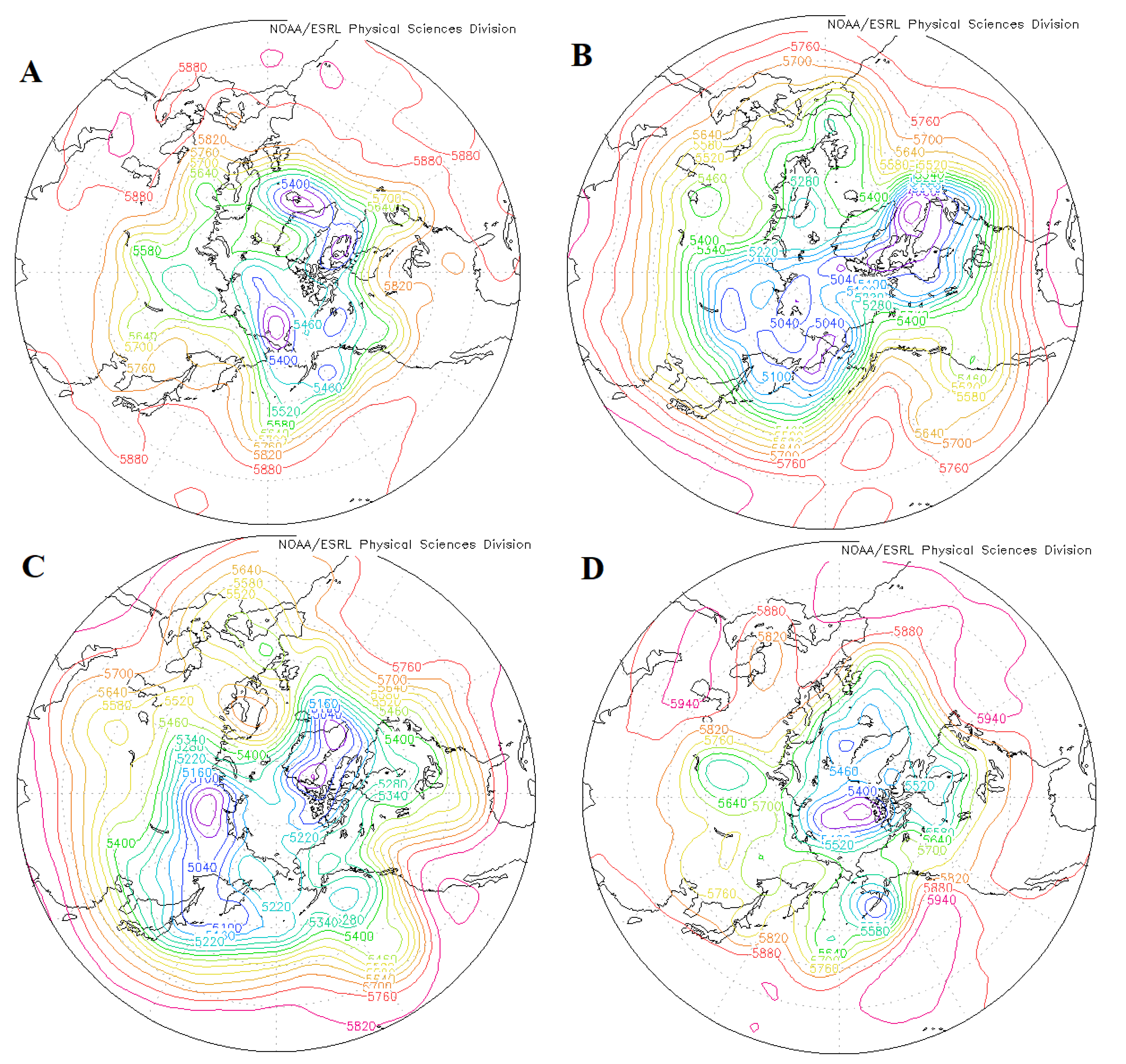
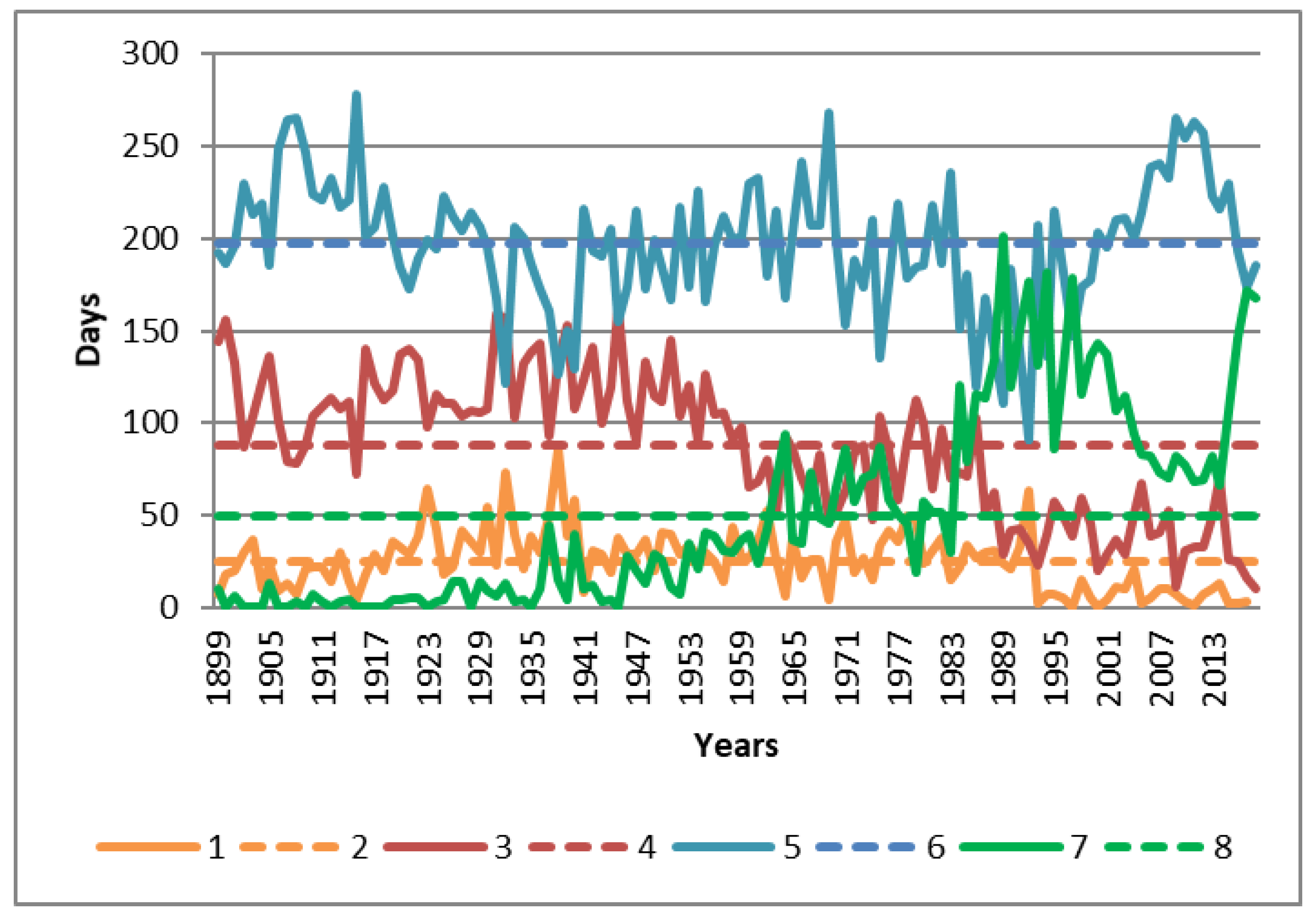
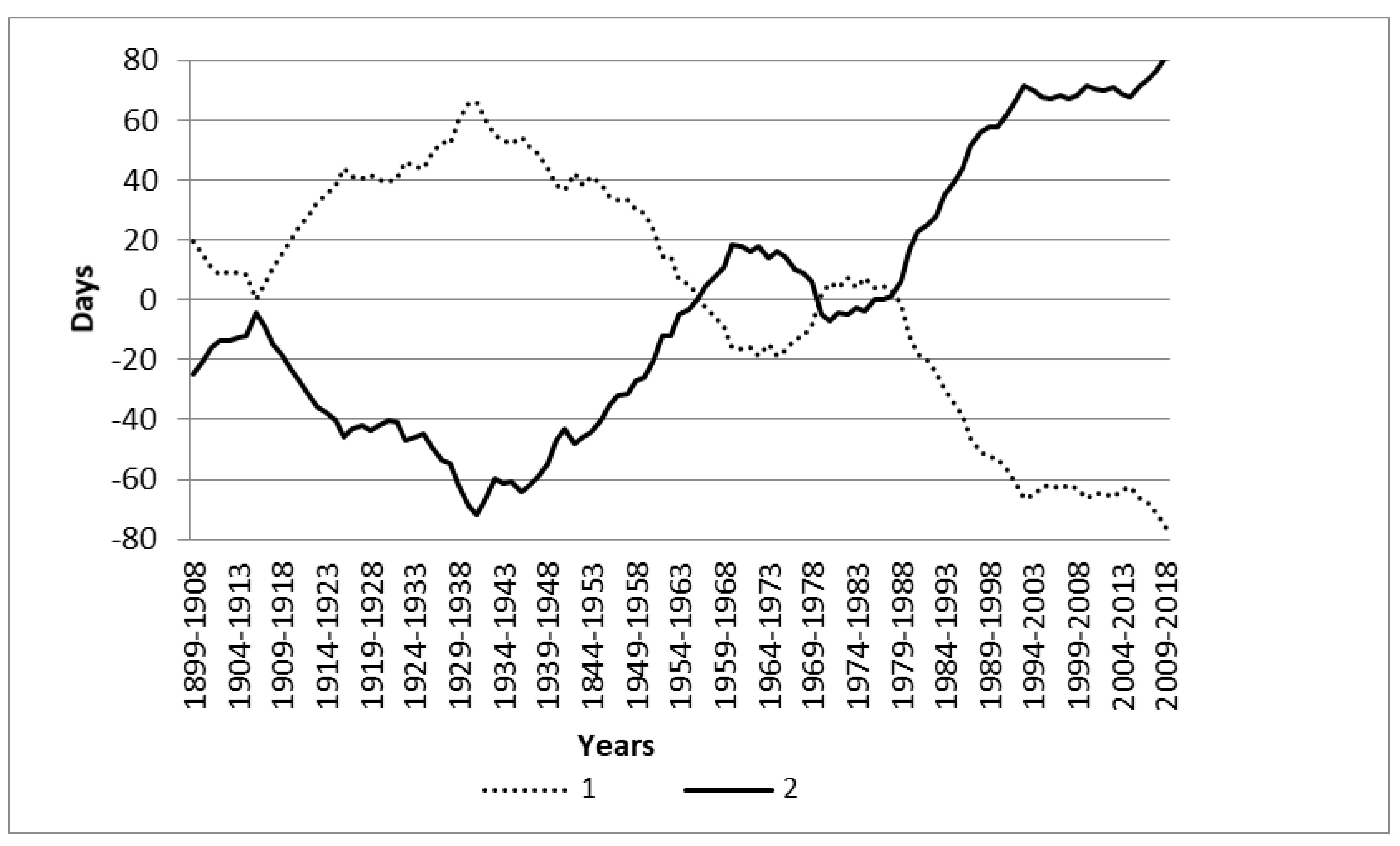
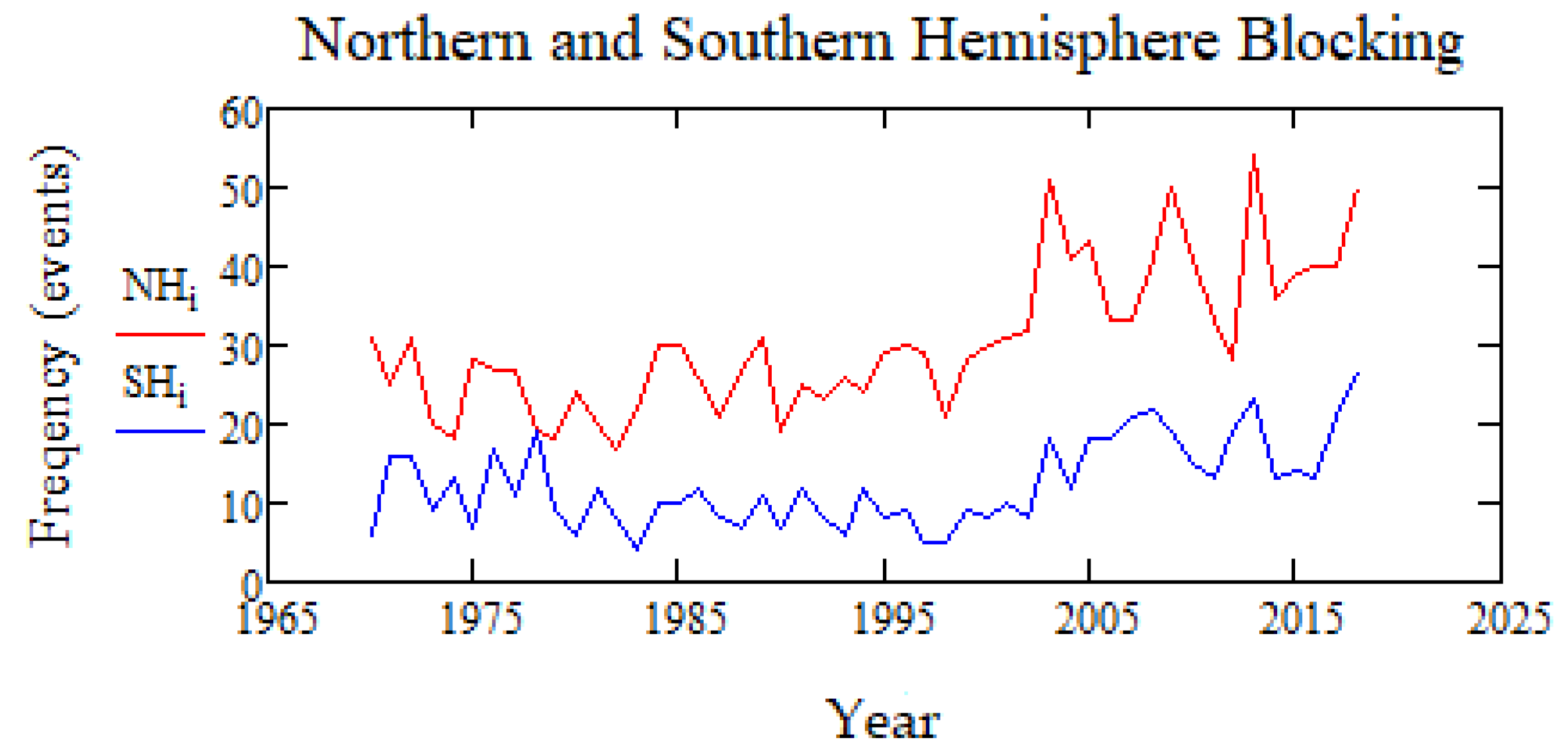
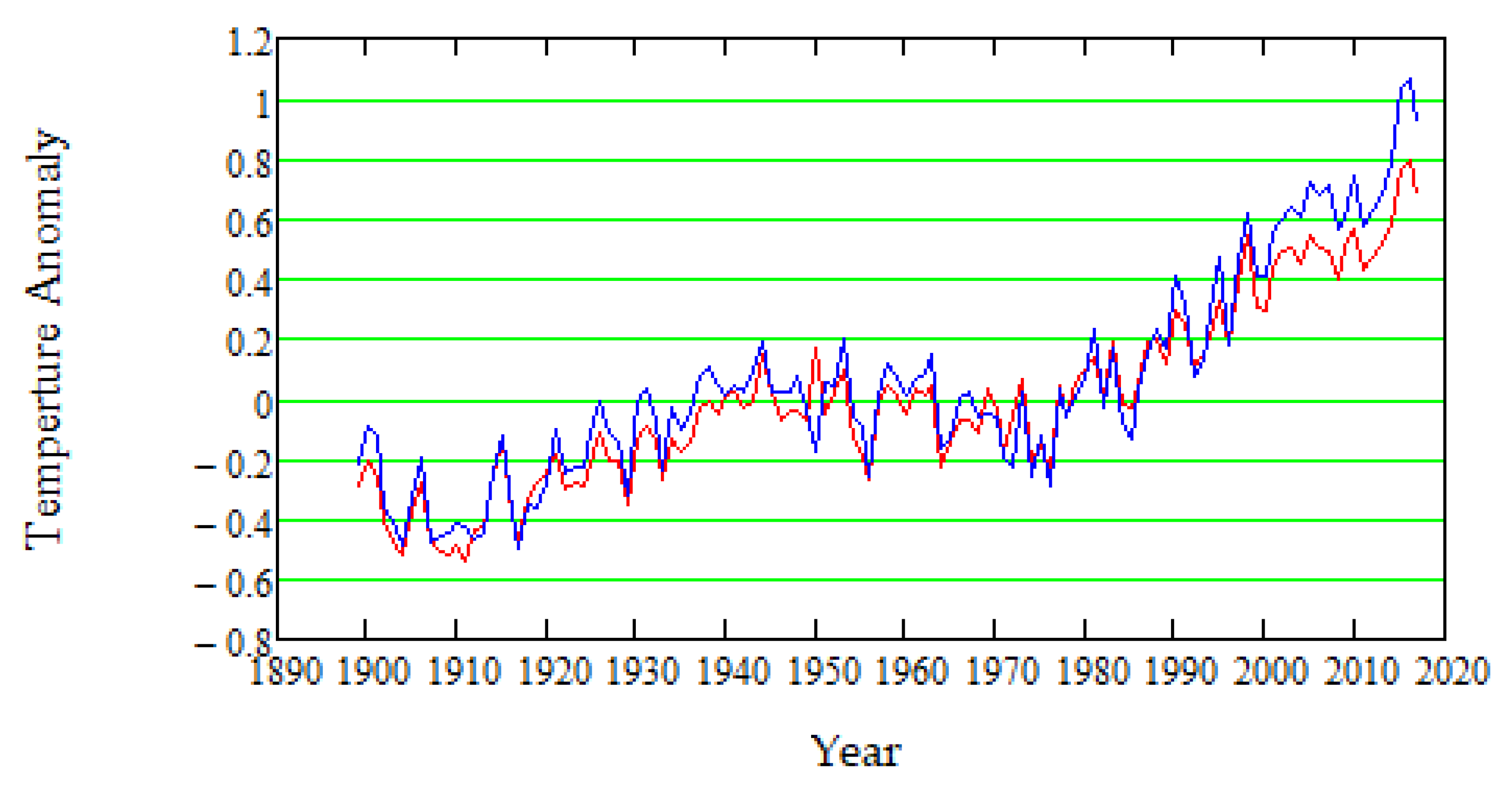
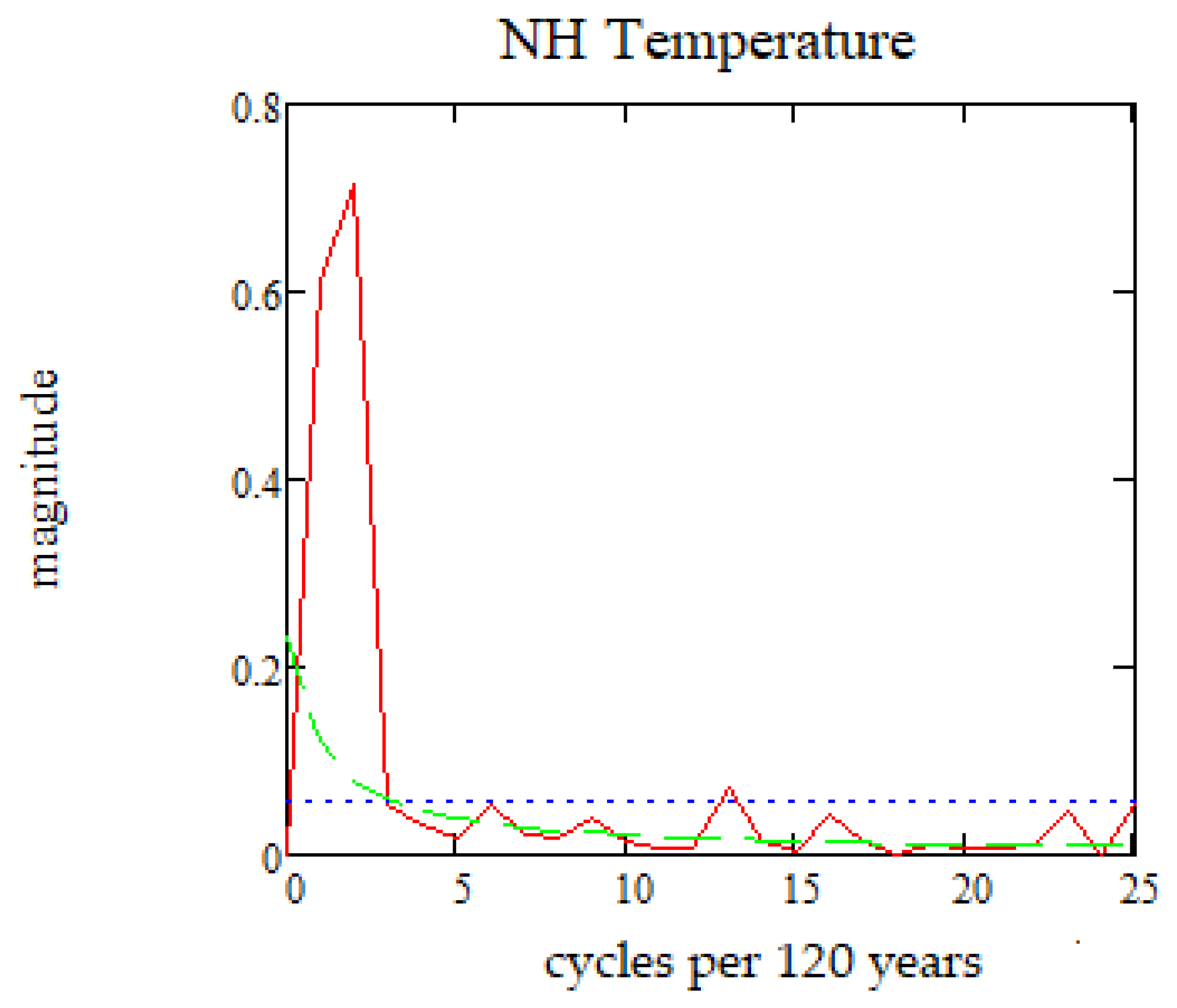
| Circulation Group | ECMs Included | Atmospheric Pressure at the North/South Pole | Number of Amplified Waves |
|---|---|---|---|
| Zonal (Type 1) | 1–2 | High | 0 |
| Zonal Breaking (Type 2) | 3–7 | High | 1 |
| Amplified Ridging (Type 3) | 8–12 | High | 2–4 |
| Equatorward Troughs (Type 4) | 13 | Low | 3–4 |
| Seasons | Date (s) | Dominant ECMs |
|---|---|---|
| Winter (NH)/Summer (SH) | 26 Nov–8 March | 5a,b,d, 7aw,bw, 11a,b,c, 12bw,cw, 13w |
| Summer (NH)/Winter (SH) | 24 May–31 August | 2a,b,c, 3, 4b,c, 6, 7as,bs, 8bs,cs,ds, 9a, 10b, 13s |
| Spring/Fall | 9 April–8 May/1 September–7 October | 10a, 12a,bs,cs |
| Pre-spring/Pre-winter | 9 March–8 April/8 October–25 November | 1a,b, 4a, 5c, 8a,bw,cw,dw, 9b, 11d,12d |
| Epoch | Occurrence of Zonal Versus Meridional Flow (Z/M) | Information Entropy |
|---|---|---|
| Random | 0.50/0.50 | 1.00 |
| Expected DKV46 | 0.44/0.56 | 0.99 |
| Observed 1899–2018 | 0.31/0.69 | 0.90 |
| Epoch 1 1899–1915 | 0.36/0.64 | 0.94 |
| Epoch 2 1916–1956 | 0.44/0.56 | 0.99 |
| Epoch 3 1957–2018 | 0.22/0.78 * | 0.76 * |
| Sub-period 1 1957–1969 | 0.28/0.72 | 0.86 |
| Sub-period 2 1970–1980 | 0.32/0.68 | 0.90 |
| Sub-period 3 1981–1997 | 0.26/0.74 | 0.82 |
| Sub-period 4 1998–2018 | 0.13/0.87 ** | 0.57 ** |
© 2020 by the authors. Licensee MDPI, Basel, Switzerland. This article is an open access article distributed under the terms and conditions of the Creative Commons Attribution (CC BY) license (http://creativecommons.org/licenses/by/4.0/).
Share and Cite
Kononova, N.K.; Lupo, A.R. Changes in the Dynamics of the Northern Hemisphere Atmospheric Circulation and the Relationship to Surface Temperature in the 20th and 21st Centuries. Atmosphere 2020, 11, 255. https://doi.org/10.3390/atmos11030255
Kononova NK, Lupo AR. Changes in the Dynamics of the Northern Hemisphere Atmospheric Circulation and the Relationship to Surface Temperature in the 20th and 21st Centuries. Atmosphere. 2020; 11(3):255. https://doi.org/10.3390/atmos11030255
Chicago/Turabian StyleKononova, Nina K., and Anthony R. Lupo. 2020. "Changes in the Dynamics of the Northern Hemisphere Atmospheric Circulation and the Relationship to Surface Temperature in the 20th and 21st Centuries" Atmosphere 11, no. 3: 255. https://doi.org/10.3390/atmos11030255
APA StyleKononova, N. K., & Lupo, A. R. (2020). Changes in the Dynamics of the Northern Hemisphere Atmospheric Circulation and the Relationship to Surface Temperature in the 20th and 21st Centuries. Atmosphere, 11(3), 255. https://doi.org/10.3390/atmos11030255






